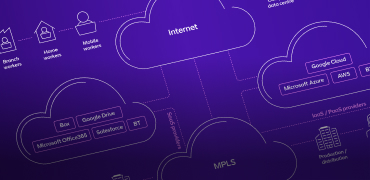Future-ready infrastructure: Cloud-native application development
Move closer to the cloud by choosing the right global infrastructure provider.

The world moved from mainframes to distributed computing, then to cloud and now towards Edge computing.
The next logical step is the use of distributed quantum computers to deliver the ever-growing demand for over-the-top services. For example, across the globe, in the subscription video-on-demand sector, the number of users is expected to rise to 1.6bn by 2027 . Devices at home and work all around the world, are routing through Edge devices, through to the cloud, via telecommunications network infrastructure; all so that content can be uploaded, shared and viewed on applications such as Facebook, WhatsApp, Teams, Outlook, Amazon, Netflix, and Instagram. It’s business critical that all these applications provide a reliable, always-on user experience, that protects and connects people, devices, and businesses to keep the digital world moving.
To keep pace with the constantly evolving digital world means that changes and upgrades to digital processes are inevitable. Striking the right balance between development and operations is key to effectively managing budgets, resource allocation and your people’s time. It’s nearly impossible to have cloud, network, security, and bandwidth within proximity to every user of every application they’re running. So, is there a way to model the performance and manage the resources better? The answer is yes, the solution is to partner with someone who has that infrastructure already in place, like an organisation who provides end-to-end architectures globally.
How would this work, let’s look at an example:
An automotive Original Equipment Manufacturer (OEM) wants to spin up virtual machines and deploy containerised applications to enable reliable access, 24/7 to its cars. This is driven by a number of trends, such as autonomous driving, connectivity, electrification, and shared mobility. They want to concentrate on core operations without worrying about maintaining and monitoring on-premises infrastructures.
A multi-cloud telco partner can provide:
- Site reliability engineering: providing a reliable connection to all availability zones of the various public cloud providers including private cloud hosted in third party data centres and owned edge compute infrastructure. Or private cloud everywhere with the right network and integrated security to protect users.
- Software supply chain: to retain a competitive edge, it’s imperative for the OEM to deploy software updates during production in an automated and controlled fashion after common vulnerabilities and exposure checks.
Most software architects agree that application performance degrades when a poor network fabric is in place. If software development started in the cloud, then by definition it’s cloud-native because it can easily leverage various tools e.g. backing services (any service on which an applications contacts over the network during its operation) available in the cloud. To organise and guarantee access from anywhere, software packages are deployed in containers using a platform like Docker, and orchestration tools such as Kubernetes. This makes it much simpler to deliver a continuous stream of small incremental changes to product features and functionality, especially when a large-scale production system is in place.
This level of portability is essential in terms of developing process and vendor compatibility plus it solves the headache of how to make sure that software runs correctly when it’s moved from one computing environment to another. It also has other benefits, such as fault isolation and security. Kubernetes can give you a further layer of control by providing automation and enable scaling of container-based workloads for live production environments. Plus, an easy to manage underlying infrastructure resource for containerised applications with actionable insight to provide an extra layer of control.
This use case and others need a telco partner who can approach from a cloud vendor-agnostic perspective, implementing network services as needed, delivering right at the edge via Anthos, Outpost, Azure Stack or your own BareMetal. In many cases the nearest data centre is still a long way from where you need the cloud. A telco partner can bridge that gap because their infrastructure footprint will likely have global reach and be plugged in to the cloud providers allowing you to link users and the cloud without having to build yourself.
The exponential adoption of cloud services is driven by its own success. As cloud moves closer to users it’s important to look for the nearest cloud through a next generation cloud-network operator. At BT we can place containers in the right edges using hybrid or multi-cloud managed solutions that will orchestrate through Kubernetes without having to phase out your existing infrastructure.
We offer a complimentary two-hour cloud discovery session where we’ll help your organisation better understand how to leverage various cloud technologies and services. This will enable you to deliver valuable insights to your key stakeholders and accelerate outcomes, while reducing the overall risk to your business. Following the session, we’ll craft a proposal with recommended next steps for your team.
Would you like to talk to a specialist? If so please get in touch. Or visit our website for more information about our hybrid cloud solutions.


